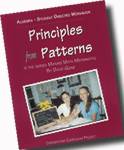Principles from Patterns is designed to follow immediately after Cornerstone Curriculum's Level 6 of Making Math Meaningful. However, students working in other publishers' math series can use this course for a high school algebra course. It covers pre-algebra topics (positive and negative numbers, radicals, exponents, order of operations, etc.). Then it goes on to cover equations, polynomials, factoring, the Pythagorean theorem, and the quadratic formula—the basic topics covered in first-year algebra courses. However, coverage is less comprehensive than we find in most other first-year algebra courses.
This textbook has a lay-flat binding, and an answer key is included within the book. (Additional copies of the textbook may be purchased at half price.)
Principles from Patterns incorporates the use of manipulatives (Unifix Cubes® and heavy graph paper cut into shapes resembling Base Ten materials) that make it much easier to grasp some of the abstract concepts. Unifix Cubes (sold separately by Cornerstone and others) are used in conjunction with grid paper included within the book. However, LEGO® bricks can be substituted. The grid paper also works well as a manipulative.
Teens who need concrete learning experiences will particularly benefit from the teaching methods used here. Those who function well on an abstract level should also benefit with better understanding of concepts, although they might be able to shortcut through some of the hands-on activities.
Principles from Patterns frequently uses Inductive teaching methods that lead learners to discover concepts for themselves rather than just memorize rules and study examples.
Topics are covered in a progressive fashion, working toward mastery of each concept. At the end of each unit is a review lesson to ensure retention and understanding of previously learned concepts. The many word problems within each unit help students understand the practical application of concepts.
Unlike the younger level Making Math Meaningful courses, this one does not offer a script ("Say this," "Do this"), but speaks directly to the learner. Because of this, many students will be able to work independently.









